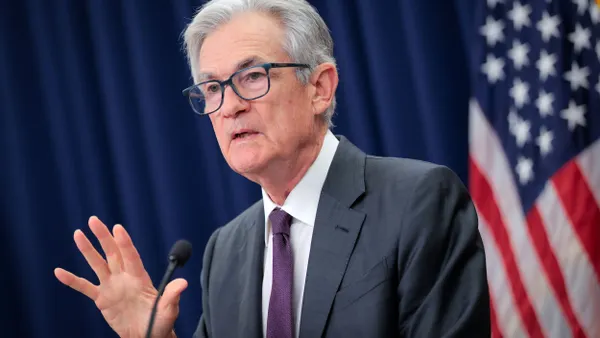Dive Brief:
- Jobless claims fell early this month, government data showed Thursday, underscoring resilience in the labor market even as the highest tariffs in decades, along with warnings from Wall Street, cast doubt on the future strength of economic growth.
- The number of people filing unemployment insurance claims declined to 228,000 during the week ended May 3 from 241,000 during the previous week, the Labor Department said.
- Continuing unemployment claims, measuring the number of unemployed workers, fell to 1.88 million during the week ended April 26 compared with 1.91 million during the prior week.
Dive Insight:
Both private- and public-sector economists have flagged risks to the outlook for jobs and the economy following the Trump administration announcement on April 2 of 10% baseline tariffs against most U.S. trading partners and 145% import duties on goods from China.
“If the large increases in tariffs that have been announced are sustained, they're likely to generate a rise in inflation, a slowdown in economic growth and an increase in unemployment,” Federal Reserve Chair Jerome Powell said Wednesday after policymakers decided not to alter borrowing costs.
Economists at Goldman Sachs, Citigroup and several other organizations have warned that import duties may slow economic growth, spur inflation and harm employment.
Powell said the job market is currently steady, noting 4.2% unemployment in April.
“The unemployment rate remains low, and the labor market is at or near maximum employment,” he said.
When assessing whether to trim the federal funds rate, policymakers will look at labor force participation, wage growth and unemployment, including the pace of any rise in joblessness, Powell said.
“We would look at the whole huge array of labor market data to get a sense of whether conditions are really deteriorating or not,” he said.
U.S. companies have kept payrolls largely intact despite the hard-to-predict outcome from changes by President Donald Trump to trade, regulatory, immigration and tax policies.
The economic outlook is especially murky, Powell said.
“There's so much uncertainty,” he said. “If you talk to businesses or market participants or forecasters, everyone is just waiting to see how developments play out, and then we'll be able to make a better assessment of what the appropriate path for monetary policy is.”
“We think right now the appropriate thing to do is to wait and see how things evolve,” he said, noting that the decision by policymakers to keep the federal funds rate at a range between 4.25% and 4.5% was unanimous.
Consumer expectations for the job market slumped last month, the New York Fed said Thursday.
“Labor market expectations largely deteriorated in April, with households having lower expectations for both earnings growth and finding a job,” the New York Fed said in a report on a monthly survey.
The mean probability that the unemployment rate will rise in a year rose by 0.1 percentage point to the highest reading since April 2020, the New York Fed said, citing the survey.
Median one-year-ahead expectations for earnings growth fell by 0.3 percentage point to 2.5%, the lowest reading since December 2023, according to the New York Fed.













